Jewish Histories in Multiethnic Boyle Heights
Curated by: Caroline Luce
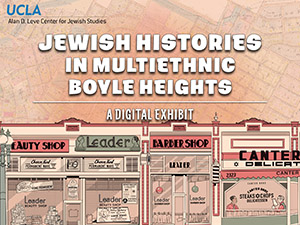 In the 1930s, Boyle Heights—with its main throughway, Brooklyn Avenue—was home to some 10,000 Jewish households, about a third of the Los Angeles Jewish population and the highest concentration of Jews west of the Mississippi. Jewish community life flourished with dozens of synagogues, charitable institutions, cultural organizations, schools, and community centers, not to mention Jewish-owned bakeries, kosher butcheries, delis, restaurants, and movie theaters. This vibrant Jewish community emerged in a multiethnic context, in one of the most diverse neighborhoods in Los Angeles called home by thousands of Mexican, Japanese, Armenian/Turkish, Italian, Russian, and African American families. Using archival materials shared by a variety of museums, libraries, and community partners, this digital exhibition aims to locate Boyle Heights’ Jewish histories within this multiethnic context, revealing both the diversity of Jewish experiences in Boyle Heights and the ways those experiences coincided with, and diverged from, those of the other diasporic communities that settled there.
In the 1930s, Boyle Heights—with its main throughway, Brooklyn Avenue—was home to some 10,000 Jewish households, about a third of the Los Angeles Jewish population and the highest concentration of Jews west of the Mississippi. Jewish community life flourished with dozens of synagogues, charitable institutions, cultural organizations, schools, and community centers, not to mention Jewish-owned bakeries, kosher butcheries, delis, restaurants, and movie theaters. This vibrant Jewish community emerged in a multiethnic context, in one of the most diverse neighborhoods in Los Angeles called home by thousands of Mexican, Japanese, Armenian/Turkish, Italian, Russian, and African American families. Using archival materials shared by a variety of museums, libraries, and community partners, this digital exhibition aims to locate Boyle Heights’ Jewish histories within this multiethnic context, revealing both the diversity of Jewish experiences in Boyle Heights and the ways those experiences coincided with, and diverged from, those of the other diasporic communities that settled there.
In the years after World War II, as construction began on a series of freeways and public housing projects in and around the neighborhood, Jewish residents began leaving Boyle Heights en masse. By the 1960s, the neighborhood was home to a Mexican American majority, whose experiences with social and economic marginalization, police violence, and urban renewal were different than those of residents before them. And yet, many patterns of resistance, cultural expression and community organizing endured, taking new and dynamic forms. To celebrate this efflorescence of Chicano/a cultural and political activity, Brooklyn Avenue was renamed Avenida César Chávez (César E. Chávez Avenue) in 1994 and a portion of the street designated as the Brooklyn Avenue Historic Neighborhood Corridor. By bringing the many, overlapping layers of the neighborhood’s past into focus, “Jewish Histories in Multiethnic Boyle Heights” invites users to think critically about how an array of stakeholders—both within the neighborhood and without—have generated and enacted ideas about its religious, social, and cultural identity and how the Jewish community’s relationship to the neighborhood has changed over time.
100 Years of Sephardic L.A.
Curated by: Sarah Abrevaya Stein and Caroline Luce
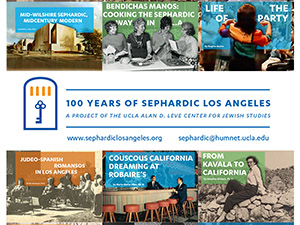 Originally founded by Jews from Turkey, Greece, Ottoman Palestine, and the Island Rhodes at the turn of the 20th century, L.A.’s Sephardic community today includes native-born Angelenos and immigrants from Iran, Morocco, Tunisia, Algeria, Egypt, Iraq, Syria, Lebanon, and Israel, each with their own traditions, institutions and cultural forms. Los Angeles thereby holds the key to a complex story of Jewish migration and urban diversity, one in which multiple Jewish diasporas met, collided, merged, built communities, and maintained their cultural distinction while nonetheless becoming threads of a larger California fabric. And yet the story of migration, settlement, and civil and cultural life of the diverse community of Mediterranean and Middle Eastern Jews to and in the City of Angels has yet to be systematically taught, written, or told.
Originally founded by Jews from Turkey, Greece, Ottoman Palestine, and the Island Rhodes at the turn of the 20th century, L.A.’s Sephardic community today includes native-born Angelenos and immigrants from Iran, Morocco, Tunisia, Algeria, Egypt, Iraq, Syria, Lebanon, and Israel, each with their own traditions, institutions and cultural forms. Los Angeles thereby holds the key to a complex story of Jewish migration and urban diversity, one in which multiple Jewish diasporas met, collided, merged, built communities, and maintained their cultural distinction while nonetheless becoming threads of a larger California fabric. And yet the story of migration, settlement, and civil and cultural life of the diverse community of Mediterranean and Middle Eastern Jews to and in the City of Angels has yet to be systematically taught, written, or told.
Aiming to reverse these trends, “100 Years of Sephardic Los Angeles” offers a collection of 25 rich, multimedia essays that document the diverse journeys Sephardim embarked upon en route to southern California, and explore the lives, families, institutions and cultures these Jews built within the urban fabric of Los Angeles. By doing so, it offers new insight into how L.A.’s Sephardic community worked and relaxed, socialized and served their city, prayed and performed, and came to understand themselves as Jews and as Angelenos.
Curated by Professor Sarah Abrevaya Stein and Dr. Caroline Luce, this digital exhibit was created through collaboration between MJLA and the Sephardic Archive Initiative ,with support from UCLA Library Special Collections and the Maurice Amado Foundation.
HUGO BALLIN’S LOS ANGELES
Curated by: Caroline Luce
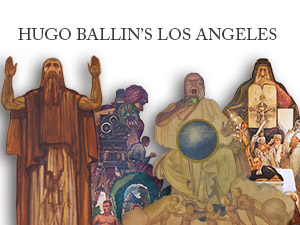 Ballin’s work decorates the interiors of buildings throughout Southern California including the Griffith Observatory, Burbank City Hall, the Wilshire Boulevard Temple and the Globe Lobby of the Los Angeles Times building. But while his murals are beloved by many, historical details about his life and scholarly reflections about his artistic career are as widely dispersed as his work. This digital exhibit uses new technologies to place Ballin’s murals side-by-side, enabling viewers to see them as a body of work, to discern their common characteristics, and to observe the subtle shifts in his painting style from his early days as an artist in the 1910s to his final commissions in Los Angeles in the 1950s.
Ballin’s work decorates the interiors of buildings throughout Southern California including the Griffith Observatory, Burbank City Hall, the Wilshire Boulevard Temple and the Globe Lobby of the Los Angeles Times building. But while his murals are beloved by many, historical details about his life and scholarly reflections about his artistic career are as widely dispersed as his work. This digital exhibit uses new technologies to place Ballin’s murals side-by-side, enabling viewers to see them as a body of work, to discern their common characteristics, and to observe the subtle shifts in his painting style from his early days as an artist in the 1910s to his final commissions in Los Angeles in the 1950s.
Es Geht Wohl Anders (Things Turn Out Differently) The Unexpected Life of Walter Arlen
Curated by: Michael Hass, Bill Katin, and Dr. Mary Pinkerson
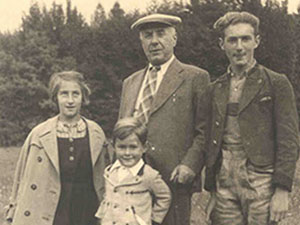 Between 1933 and 1941, some 10,000-15,000 exiles and émigrés, fleeing the destruction and persecution of Hitler and the Nazis, sought refuge in Los Angeles. Some seventy percent of these newcomers were Jewish, including internationally renowned artists, intellectuals, musicians and composers who came to the city seeking jobs in the studios of Hollywood. Their performances in Los Angeles brought to the local arts scene, enlivening institutions like the Hollywood Bowl and the UCLA Center for the Performing Arts. Es Geht Wohl Anders (Things Turn out Differently): The Unexpected Life of Walter Arlen, explores the work of an émigré critic, composer and educator who was part of this cultural revitalization.
Between 1933 and 1941, some 10,000-15,000 exiles and émigrés, fleeing the destruction and persecution of Hitler and the Nazis, sought refuge in Los Angeles. Some seventy percent of these newcomers were Jewish, including internationally renowned artists, intellectuals, musicians and composers who came to the city seeking jobs in the studios of Hollywood. Their performances in Los Angeles brought to the local arts scene, enlivening institutions like the Hollywood Bowl and the UCLA Center for the Performing Arts. Es Geht Wohl Anders (Things Turn out Differently): The Unexpected Life of Walter Arlen, explores the work of an émigré critic, composer and educator who was part of this cultural revitalization.
In Search of Fairfax
Curated by: Max D. Baumgarten
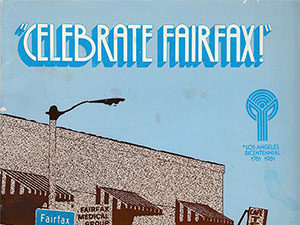 In Search of Fairfax” explores the history of Beverly-Fairfax, a mid-city neighborhood that the Los Angeles Times has described as “the symbolic focus of Jewish life in Los Angeles,” “the city’s cultural ‘Little Israel,’” “the most Jewish stretch of pavement in Los Angeles,” and the “emotional center of Jewish life in Los Angeles.” While consistently boasting the highest concentration of Jewish residents throughout Los Angeles and a plethora of schools, religious institutions, social clubs, and storefronts that chiefly catered to Jews throughout the latter half of the 20th century, the neighborhood attracted an array of Jewish and non-Jewish micro-communities and subcultures.
In Search of Fairfax” explores the history of Beverly-Fairfax, a mid-city neighborhood that the Los Angeles Times has described as “the symbolic focus of Jewish life in Los Angeles,” “the city’s cultural ‘Little Israel,’” “the most Jewish stretch of pavement in Los Angeles,” and the “emotional center of Jewish life in Los Angeles.” While consistently boasting the highest concentration of Jewish residents throughout Los Angeles and a plethora of schools, religious institutions, social clubs, and storefronts that chiefly catered to Jews throughout the latter half of the 20th century, the neighborhood attracted an array of Jewish and non-Jewish micro-communities and subcultures.
RECOVERING YIDDISH CULTURE IN LOS ANGELES
Curated by: Caroline Luce
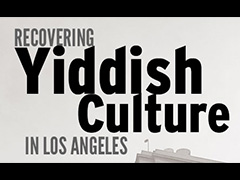 “Recovering Yiddish Culture in Los Angeles” aims to apply the digital strategies that have so greatly enhanced the field of Yiddish Studies to recover a long-forgotten body of Yiddish works: those produced by the Yiddish writers and poets who settled in Los Angeles. Published in small batches thousands of miles from the cultural capitols of Europe and the American east coast, these works – nearly 100 books and several dozen periodicals – have received very little scholarly attention.
“Recovering Yiddish Culture in Los Angeles” aims to apply the digital strategies that have so greatly enhanced the field of Yiddish Studies to recover a long-forgotten body of Yiddish works: those produced by the Yiddish writers and poets who settled in Los Angeles. Published in small batches thousands of miles from the cultural capitols of Europe and the American east coast, these works – nearly 100 books and several dozen periodicals – have received very little scholarly attention.
ON THE MAP
Curated by: Karen Wilson, Elliot Yamamoto
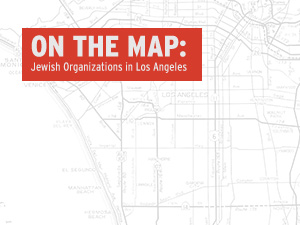 Since the mid-nineteenth century. Jews have been part of the Los Angeles landscape. Dive into historical maps to discover where and what they were up to.
Since the mid-nineteenth century. Jews have been part of the Los Angeles landscape. Dive into historical maps to discover where and what they were up to.
FROM GRAND CENTRAL MARKET TO SUPERMARKET:
LOS ANGELES JEWISH GROCERS
Curated by: Cate Roman
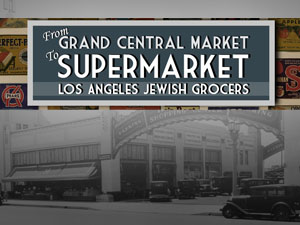 As Los Angeles grew into the modern metropolis, Jewish grocers were on the forefront of grocery store innovation and quick to adapt to changing business styles. In the 1920’s, grocery shopping shifted from clerk served to self serve and then later to the supermarket model. Jewish grocers were both central and marginal in these important economic developments.
As Los Angeles grew into the modern metropolis, Jewish grocers were on the forefront of grocery store innovation and quick to adapt to changing business styles. In the 1920’s, grocery shopping shifted from clerk served to self serve and then later to the supermarket model. Jewish grocers were both central and marginal in these important economic developments.
THE WHITE PLAGUE IN THE CITY OF ANGELS
Curated by: Caroline Luce
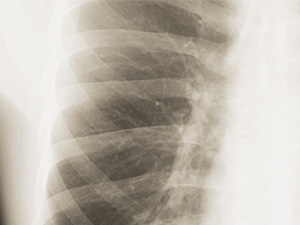 Sent by doctors from the east and Midwest to seek relief in the warm, dry climates of the West, perhaps as many as one quarter of the city’s new arrivals had come to Southern California to get well in the health resorts, spas and hospitals of an emerging “sanitarium belt.” The unintended consequences of the boosters’ campaigns to draw people to Los Angeles brought into stark relief a range of contending interests, social anxieties, and community rivalries. Examining the origins of these three institutions maps out the matrix of science, technology and treatment, public health policy, and social attitudes about disease and contagion that shaped the place of illness in healthful Southern California.
Sent by doctors from the east and Midwest to seek relief in the warm, dry climates of the West, perhaps as many as one quarter of the city’s new arrivals had come to Southern California to get well in the health resorts, spas and hospitals of an emerging “sanitarium belt.” The unintended consequences of the boosters’ campaigns to draw people to Los Angeles brought into stark relief a range of contending interests, social anxieties, and community rivalries. Examining the origins of these three institutions maps out the matrix of science, technology and treatment, public health policy, and social attitudes about disease and contagion that shaped the place of illness in healthful Southern California.
THE JEWISH PASS: THE GROWTH OF JEWISH INSTITUTIONS IN LOS ANGELES’ SEPULVEDA PASS
Curated by: Erik Greenberg
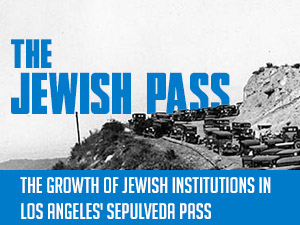 Studying the Jewish institutions that exist in the Sepulveda Pass offers physical evidence of LA Jewry’s westward movement and a glimpse into the beliefs and ideals that helped shape American Jewish observance and culture over the past fifty years.
Studying the Jewish institutions that exist in the Sepulveda Pass offers physical evidence of LA Jewry’s westward movement and a glimpse into the beliefs and ideals that helped shape American Jewish observance and culture over the past fifty years.
HOLLYWOOD’S ARCHITECT
Curated by: Karen Wilson
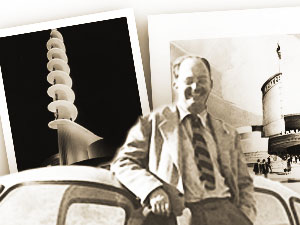 S. Charles Lee (born Levi) helped make movie-going a respectable form of entertainment, designing downtown movie palaces, suburban theaters, and drive-ins. See how he mixed commerce with art to make movie-going a national pastime.
S. Charles Lee (born Levi) helped make movie-going a respectable form of entertainment, designing downtown movie palaces, suburban theaters, and drive-ins. See how he mixed commerce with art to make movie-going a national pastime.
FROM THE BOWL TO THE BOULEVARD
Curated by: Karen Wilson, Caroline Luce
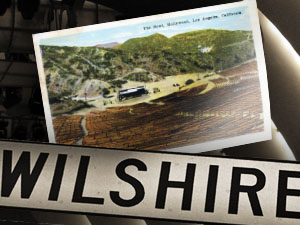 The Jewish-owned Herbert M Baruch Corporation altered the urban landscape of Los Angeles County in the 1920s, 1930s, and 1940s. Travel the breadth of the county to see how the Baruch Corporation left its mark on the metropolis.
The Jewish-owned Herbert M Baruch Corporation altered the urban landscape of Los Angeles County in the 1920s, 1930s, and 1940s. Travel the breadth of the county to see how the Baruch Corporation left its mark on the metropolis.

